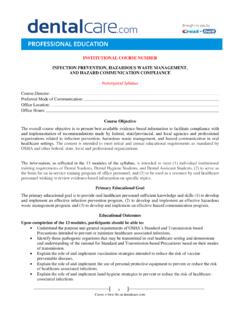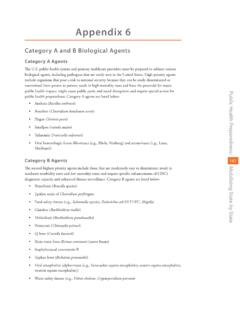Transcription of Cleaning, Sterilization & Maintenance of Surgical Instruments
1 Cleaning, Sterilization & Maintenance of Surgical Instruments 165. 165. 1. RINSING I. Use stiff plastic cleaning brushes (nylon, etc.). Immediately after surgery, rinse Instruments under warm (not hot) running water. Rinse Do not use steel wool or wire brushes except should remove all blood, body fluids and tissue. specially recommended stainless steel wire brushes for Instruments such as bone files, or 2. CLEANING on stained areas in knurled handles. (If not done immediately after rinsing, instru- ments should be submerged in a solution of II. Use only neutral PH(7) detergents because if water and neutral PH(7) detergent.) not rinsed off properly, low PH detergents will cause breakdown of stainless protective sur- A.
2 Ultrasonic Cleaning face and black staining. For micro and delicate Instruments , use manual cleaning (step C). High PH detergent will cause surface deposit of brown stain, which will also interfere with Instruments should be processed in a cleaner smooth operation of the instrument. for the full recommended cycle time . usually 5 to 10 minutes. III. Brush delicate Instruments carefully and, if possible, handle them totally separate from Place Instruments in open position into the general Instruments . ultrasonic cleaner. Make sure that "Sharp". (scissors, knives osteotomes, etc.) blades do IV. Make sure all instrument surfaces are visibly not touch other Instruments .
3 Clean and free from stains and tissue. All Instruments have to be fully This is a good time to inspect each instrument submerged. for proper function and condition. Do not place dissimilar metals (stainless, Check and make sure that : copper, chrome plated, etc.) in the same Scissors blades glide smoothly all the way cleaning cycle. (they must not be loose when in closed posi- tion). Test scissors by cutting into thin gauze. Change solution frequently at least as Three quarters of the length of blade should often as manufacturer recommends. cut all the way to the scissor tips, and not hang up. Rinse Instruments after ultrasonic cleaning with water to remove ultrasonic Forceps (pickups) have properly aligned tips.
4 Cleaning solution. Hemostats and Needle Holders do not show B. Automatic Washer Sterilizers light between the jaws, lock and unlock easily, Follow manufacturers recommendations but joints are not too loose. Check Needle Holders make sure Instruments are lubricated after for wear on jaw surfaces. last rinse cycle and before Sterilization cycle. Suction tubes are clean inside. C. Manual Cleaning Retractors function properly. Most instrument manufacturers recommend ultrasonic cleaning as the best and most Cutting Instruments and knives have sharp, effective way to clean Surgical Instruments , undamaged blades. particularly those with hinges, locks and other moving parts.
5 If ultra sonic cleaning is V. After scrubbing, rinse Instruments thoroughly not available observe the following steps. under running water. While rinsing, open and close Scissors, Hemostats, Needle Holders and other hinged Instruments to make sure the hinge areas are rinsed out, as well as the outside of the Instruments . 166 Cleaning, Sterilization & Maintenance of Surgical Instruments 3. AFTER CLEANING CAUTION At the end of the autoclave If Instruments are to be stored, let them air dry cycle before the drying cycle unlock and store them in a clean and dry environment. autoclave door and open it more than a crack (about 3/4"). Then run dry cycle for the 4.
6 AUTOCLAVING period recommended by the autoclave If Instruments are to be reused or autoclaved: manufacturer. If the autoclave door is opened fully before the drying cycle, cold A. Lubricate all Instruments which have any room air will rush into the chamber, causing "metal to metal" action such as scissors, condensation on the Instruments . This will hemostats, needle holders, self-retaining result in water stains on Instruments and also retractors, etc. cause wet packs. Recommend Surgical lubricants such as If you have any unusual staining on your instrument milk are best. Do not use WD- Instruments during Sterilization , contact your 40, oil or other industrial lubricants.
7 Local instrument representative. B. Put Instruments up for autoclaving either 5. COLD Sterilization . individually or in sets. Most cold Sterilization solutions render instru- ments sterile only after a 10 hour immersion. Individual Instruments This prolonged chemical action can be more Disposable paper or plastic pouches are detrimental to the Surgical Instruments than the ideal. Make sure you use a wide enough usual 20 minute autoclave cycle. If the instru- pouch (4" or wider) for Instruments with ments need to be "disinfected" only, cold steril - ratchet locks such as needle holders and ization is okay as disinfection will place in only hemostats so the instrument can be sterilized 10 minutes.
8 In an open (unlocked) position. But keep in mind the difference between: Instrument Sets Unlock all Instruments and sterilize them in STERILE an absolute term (no living organ- an open position. Place heavy Instruments ism survives). on bottom of set (when two layers are required). and Never lock an instrument during autoclav- DISINFECTED basically clean. ing. It will not be sterile as steam cannot reach the metal to metal surfaces. The Always use the proper Sterilization /cleaning instrument will develop cracks in hinge technique to render the instrument in required areas because of heat expansion during the condition for use. autoclave cycle.
9 For Instruments with Tungsten Carbide inserts Do not overload the autoclave chamber as (Needle Holders, Scissors, Tissue Forceps), we pockets may form that do not permit steam do not recommend use of solutions containing penetration. Place towel on bottom of pan Benzyl Ammonium Chloride which will destroy to absorb excess moisture during autoclav- the Tungsten Carbide Inserts. ing. This will reduce the chances of getting "Wet packs". Make sure the towels used in Sterilization of Instruments have no deter- gent residue and are neutral PH(7) if immersed in water. This can be a real problem as laundries frequently use inex- pensive but high PH(9-13) detergents and do not properly rinse out or neutralize those detergents in the final wash/rinse cycle.
10 Also, some times bleaches such as Clorox are added and are not neutralized.




